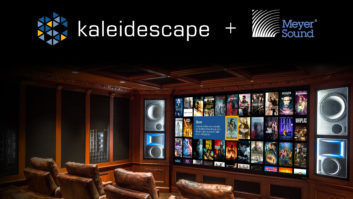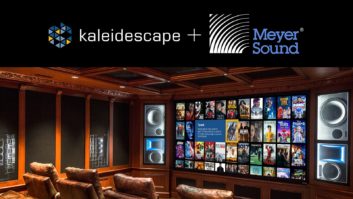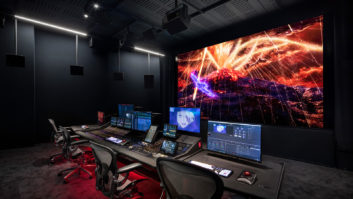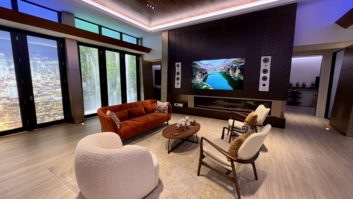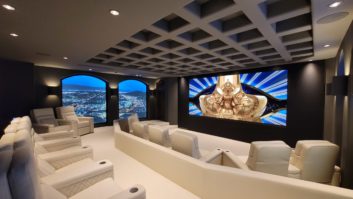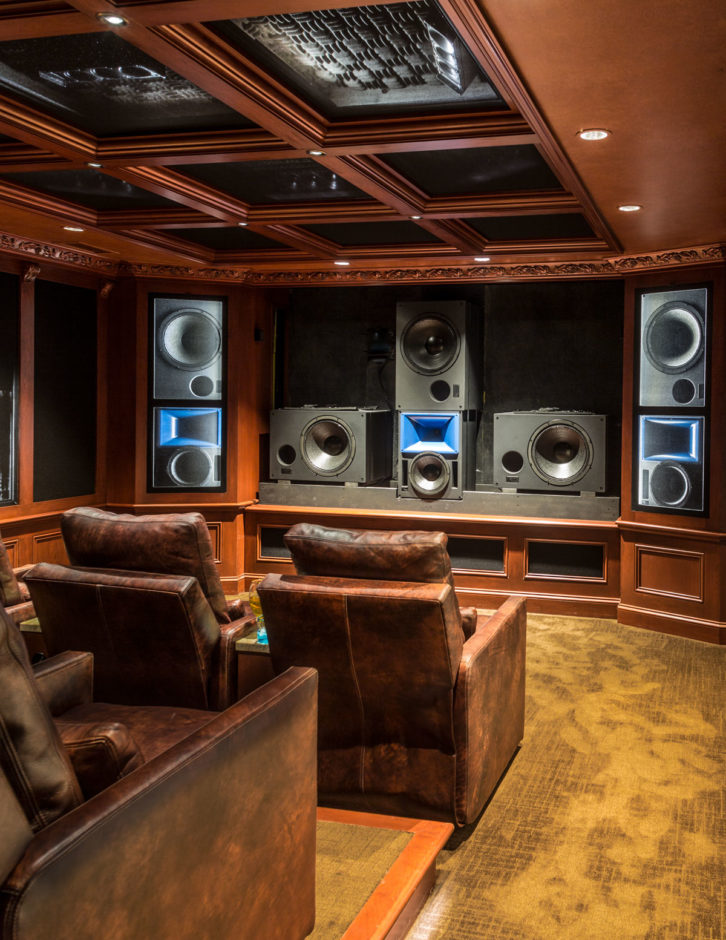
What do blockbuster film franchises have in common with the luxury home theaters whose screens they appear upon? For one thing, with each new iteration, the stakes are higher, the results need to be bigger, and the emotional impact deeper.
That was the challenge facing Gaithersburg, MD’s All Around Technology, Inc. (AAT) as the company headed in for a third major upgrade to a client’s ultra-high-end home theater.
In 1999, AAT asked Keith Yates to partner with them to design a small but spectacular room that featured a 7-channel surround system with subwoofers for each channel. The system was based on a Runco DTV-980 8-inch CRT projector with the Faroudja Line Quadrupler, while audio used the Proceed front end with Triad speakers and subwoofers throughout. BSS DSP was used to add the two additional surround channels, as well as to align and calibrate the system. This was ideal for the 5.1 laserdisc and 480i content available at that time.
Ten years later, when discrete 7.1 was introduced, the client upgraded the preamp/processors and amplifiers to Mark Levinson and replaced the video equipment with Joe Kane’s Samsung SP-A900B projector and the DVDO processor. The BSS DSP equipment was replaced by JBL Synthesis SDEC-4500, JBL’s Bass Camp was employed to upgrade the bass management, and an infrasonic subwoofer was added.
In 2018, the client said that he wanted to upgrade the original speaker system and electronics in order to play the emerging immersive music formats. Much discussion ensued with All Around Technology’s president, Tim Rooney. “We were looking to find a timbre-matched multi-channel solution that would fit in the 7 inches of existing cavity between walls and fabric,” he says. “We were aware of Meyer Sound’s amazing success in the Dolby Atmos post-production rooms of Skywalker Sound and Netflix, and we wanted to see if a flagship control room speaker system could be implemented effectively in a home. The client and I flew to Meyer Sound in Berkeley to audition the new Bluehorn System, and we were both completely blown away.”
But there was some work to do to figure out how a system could be worked into the existing mahogany millwork without significant performance impact. “I was on the steep end of the learning curve, trying to interpret the many professional and consumer recommendations for speaker placements among the various surround sound formats,” Rooney continues. “Really, it’s a mind-bender, and everybody you ask has a different take on it. Fortunately, the Meyer Sound folks have extensive experience implementing these systems for Hollywood studios and have worked directly with the engineers at Dolby, DTS, and Auro to resolve similar issues in their studios. It was amazing to work with them as they played a key role in development of the standards for playback.”
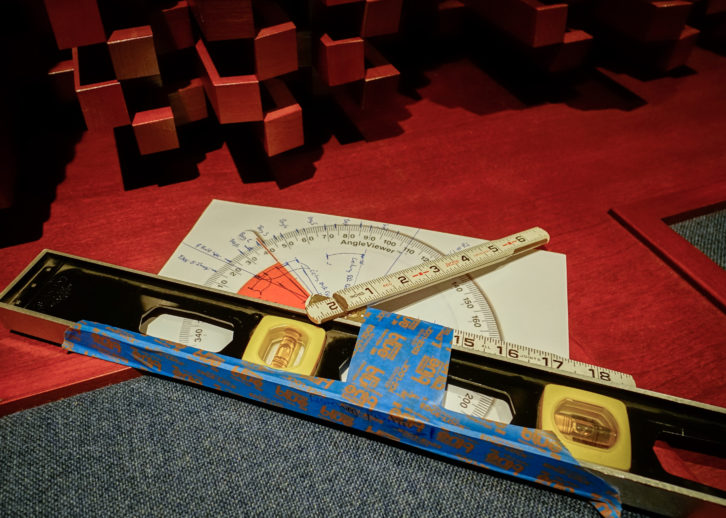
Discussions with the client were ongoing, as he is an audiophile of the first order. Rooney and the Meyer Sound team decided to start by maximizing surround speaker selection and placement for the higher-resolution and more available DTS 5.1 music format, and then filling in with surround speakers for Atmos and Auro, in that order.
“We needed to get the 5.1 music implementation right,” says Rooney, “which meant larger, horn-loaded Meyer Sound HMS-5 surround speakers would have to be used for the left and right rear surround channels. This would match the front Bluehorn System LCR both in dynamics and timbre. We needed to place the HMS surrounds in the 5.1 primary surround position, but the channel definitions and the required angular locations vary by format.”
Related: The State of Surround Sound
Routing signals for the various formats was the next challenge. “We were drawn to Trinnov’s approach, as their focus has always been on speaker mapping and their implementation is fluid and flexible for installer and end user,” says Rooney. “For example, in the DTS world, the surround locations are called ‘Surround,’ but in Atmos, the primary surrounds are the ‘Side’ speakers — 90 degrees from the listening position — and the rear corner placement would be considered ‘Rear.’ Fortunately, DTS and Auro agree on Side and Rear — or Back — speaker placement, but Atmos considers that placement to be the secondary, inside rear speaker location — or ‘Rear1’ — after the primary rear corner location. Atmos and DTS both use a front ‘Wide’ that are similar in location, but Auro does not use this channel at all.”
The ceiling was easier. Top Front Left and Right and Top Rear Left and Right are all mostly compatible with all three formats. The final design added both ‘High Center’ at the top front middle and ‘Top’ for the central ‘Voice of God’ channels in order to be fully compatible with the Auro 11.1 movie format.
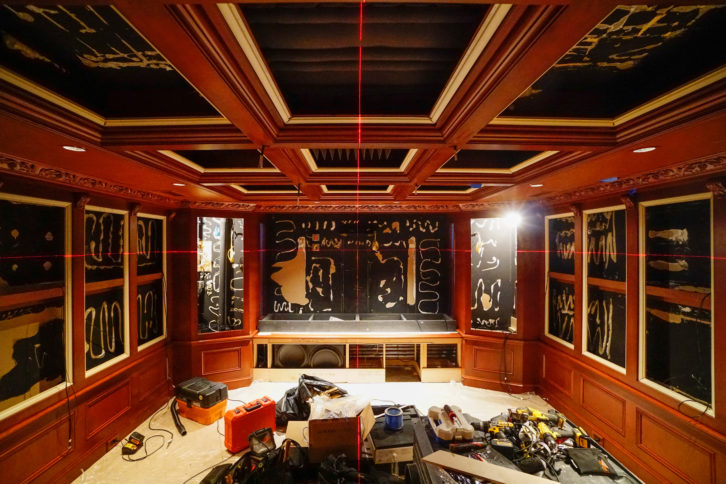
These last two channels enabled the client to legitimately cover all existing surround formats with one physical speaker layout. The Trinnov automatically remaps all these locations among the different formats, and it also provides native manual overrides, which was a specific client request. Additionally, this preamp/processor has the capability to adjust the apparent speaker positions in the listening space, allowing minor deviations from the format location specs to be made up in the Trinnov’s spatial processing.
“As we were working through the scenarios, we were doing very precise field mockups of the various possible speaker locations to see how they would fit into the existing mahogany millwork package,” says Rooney. “Using lasers, we could see precisely where first reflections of various speakers would be, and we could measure the various horizontal interactions with the millwork in terms of reflections.”
The procedures also helped to confirm the exact fitment of the top speakers and what freedom they could have in their angular placement. “Even in 3D CAD, this would be a challenge to get right on paper. In this respect, it was great to be working in the constraints of an existing structure,” says Rooney. “Amazingly, all these critical speaker locations worked well in the fabric fields designed by Keith Yates 21 years ago. Keith and I laughed that he had done his job too well the first time, as the room renovation needed no re-design.”
Tangled Up in Blue(horn)
Because the room would be equally devoted to music listening, additional considerations were involved in the 2020 renovation. Rooney had done a very high-end, 2-channel music listening room down the hall from this home theater a couple of years prior, and the client wanted to be sure the new room would offer a compatible environment.
Having survived the previous upgrade, it was decided to replace the 20-year-old Triad Platinum front speakers, the four surrounds, and the seven subwoofers. Knowing his client wanted a precise listening environment for both immersive music and movies, Rooney had suggested Meyer Sound’s Bluehorn System full bandwidth studio monitors, 14 surrounds, and two subwoofers.
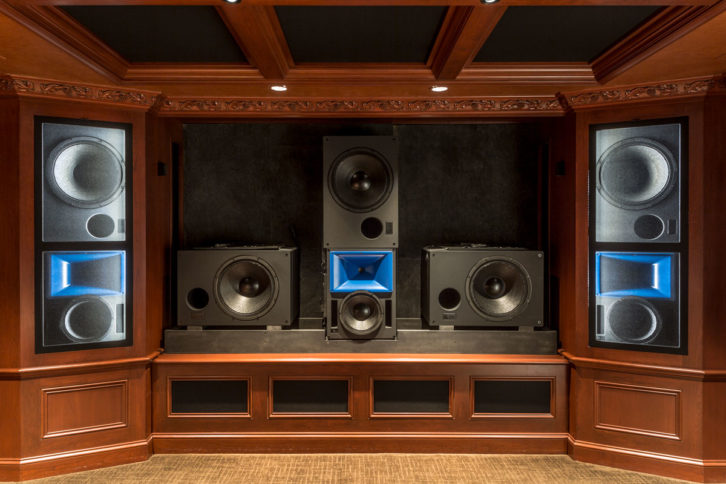
While Meyer Sound is fairly new to the residential market, they have made a name in the professional post-production community, with the brand featured at facilities such as Fox and Warner Brothers, as well as the previously mentioned Skywalker Sound and Netflix. The building momentum of the Bluehorn System has also found a home on the famed Newman Scoring Stage at Fox in Los Angeles, in film score composer John Powell’s private studio, and at other key cinema and music facilities around the world.
According to Meyer Sound, the goal of the Bluehorn System was “to build a high-power loudspeaker system that maintains absolute amplitude and phase linearity throughout the audible frequency spectrum. Using advanced digital modeling and an integrated systems approach, Bluehorn restores the precise phase relationships of the input signal at the acoustical output, assuring unprecedented accuracy and transparency.”
Each Bluehorn System channel comprises a two-way, full-range loudspeaker and a separate low-frequency extension loudspeaker with a linear frequency and phase response from 25 Hz to 22 kHz.
To complement the full-bandwidth Bluehorn System, which would act as front left, center, and right channels, Rooney chose the Meyer Sound UP-4slim for the 12 other surround speakers. “The trouble with Side and Top speakers in residential is that there’s just not enough room to turn them toward the listener because they’re generally housed in fairly large-sized boxes to get the SPL,” he says. “Meyer made this little skinny speaker that’s 4 1/4 inches wide and 5 3/4 inches deep that puts out 116 dB, and its parameters are built to agree with the Bluehorn’s timbre. It’s a great pairing that also allowed us to use the fabulous Meyer Sound Galileo GALAXY DSP environment, which allows Meyer to do time-alignment and calibration to the system as a whole.”
To augment power in the all-important LFE range, Rooney specified a pair of X-400C cinema subwoofers.
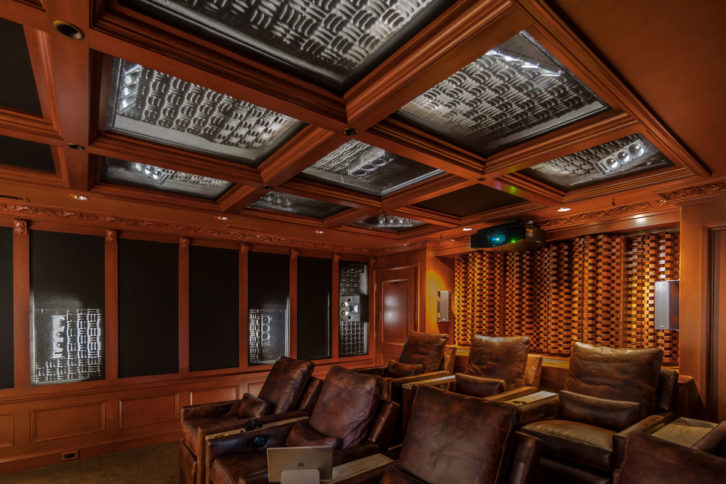
Room Tune Up
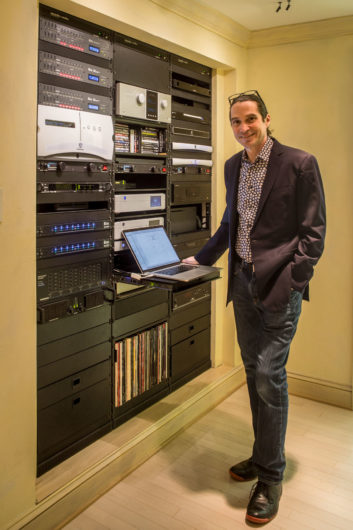
Once the system was semi-complete, Miles Rogers, Meyer Sound’s business development manager for cinema and content creation markets, flew in to commission the room. “Miles spent three days on site working with us to get the speaker mappings and surround modes working well and get the system calibration roughed in. It sounded amazing, but we still had some final room treatments, lighting, and fabric installation to complete,” says Rooney.
About six weeks later, Rogers flew back out and spent a few more days doing final calibration, including a full day working with the client on voicing. Everyone was very happy with how the system came together and seamlessly transitioned among music formats and over to the cinema application at the touch of a button.
And the performance? “The immersive quality is over the top,” says Rooney. “It’s like being in headphones, except it’s outside your head and your whole body feels the dynamic quality of the music. The physical sensations of this high dynamic-range system bring a whole additional level of ‘being there.’ It’s true immersion!”
Lighting the Big Reveal
AAT’s business model relies on specialist consultants for various technical areas of their projects, and in this case they knew they needed something special for the lighting. “Given that the Bluehorns look so cool, and the surprisingly large quantity of speakers hidden in the walls and ceilings, the client wanted a ‘big reveal,’ where you push the button and all the hidden speakers light up. We only had 7 inches to get the speaker in and did not have a lot of room for fixtures,” says Rooney, “but we have a lighting designer who does museum display lighting, and he came up with a few interesting little fixture widgets that would work. Then we spent a month in there, carefully working out the installation and the lighting. For the screen, we tried 14 different fabrics to get the one that has the right amount of acoustic transparency, but at the same time still looked black when not backlit.”
The bottom line: “It all worked”, says Rooney with a smile, “You think you are in a classically detailed, formal room and then…boom! It turns out, you’re in hi-fi heaven!”
